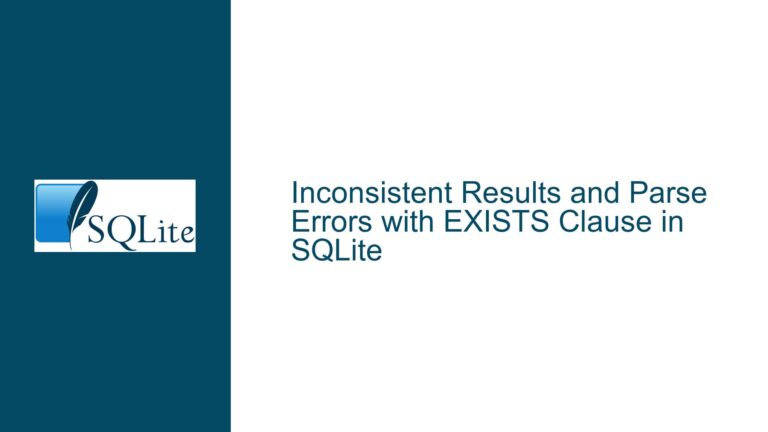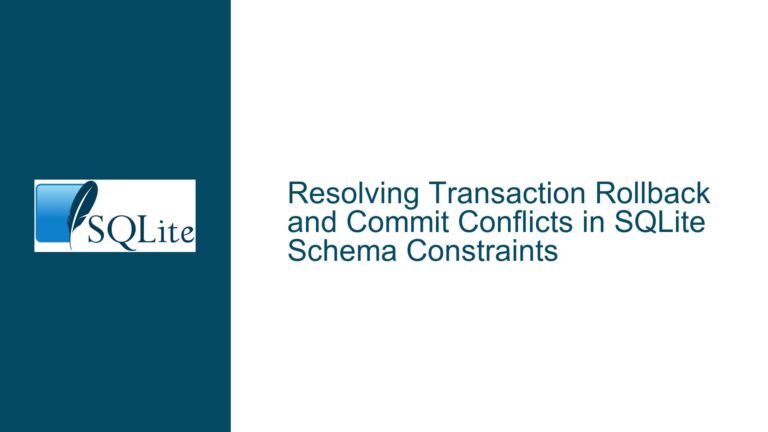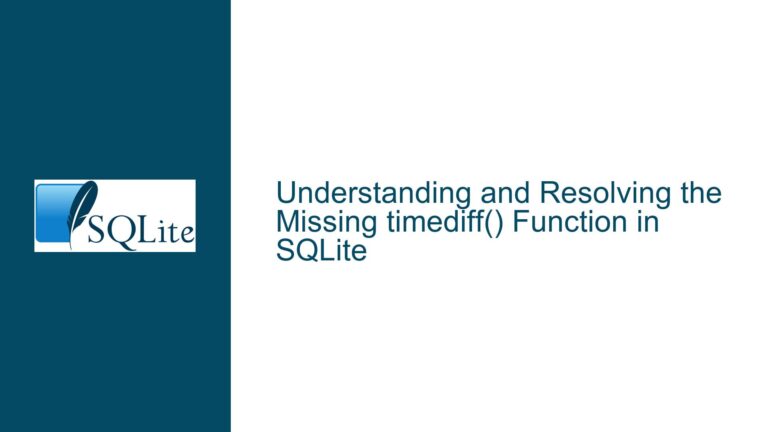the IS Operator in SQLite: NULL Handling, Boolean Logic, and Semantic Comparisons
IS vs. =: Navigating NULL Semantics, Boolean Aliases, and Type Casting in SQLite
Issue Overview
The IS operator in SQLite serves a specialized role in evaluating semantic equivalence, particularly when dealing with NULL values, boolean logic, and scenarios where standard equality checks (=) yield ambiguous or counterintuitive results. Unlike =, which adheres to mathematical equality rules, IS operates under stricter logical constraints that resolve edge cases involving NULL and boolean aliases (e.g., TRUE/FALSE).
Core Problem: Developers often misuse = in contexts where IS is required, leading to incorrect query results. For example:
NULL = NULLreturnsNULL(unknown), butNULL IS NULLreturnsTRUE.5 = TRUEevaluates toFALSE(sinceTRUEis an alias for1), but5 IS TRUEevaluates toTRUE(due to boolean evaluation rules).
This discrepancy arises from SQLite’s handling of NULL as a marker for "unknown" or "missing" data and its unique interpretation of boolean literals. The IS operator bypasses the pitfalls of three-valued logic (True/False/Unknown) inherent in SQL’s treatment of NULL, providing deterministic outcomes.
Key Concepts:
- Three-Valued Logic: SQLite evaluates expressions involving
NULLtoNULL(unknown). This includes comparisons likeNULL = NULLor5 = NULL. - Boolean Aliases:
TRUEandFALSEare aliases for1and0but behave differently when paired withIS. - Implicit Type Casting: SQLite dynamically casts values during comparisons, which can lead to unexpected results when mixing integers, booleans, and
NULL.
Root Causes: Why IS and = Yield Different Results
1. NULL Semantics and Codd’s Substitution Principle
The NULL value in SQL represents an absence of data. According to Codd’s Substitution Principle, any expression containing NULL should be treated as "unknown," meaning it could hypothetically resolve to either TRUE or FALSE if NULL were replaced with a concrete value. However, this principle leads to logical inconsistencies:
NULL = NULLevaluates toNULL(unknown), notTRUE.NULL IS NULLevaluates toTRUEbecauseIStreatsNULLas a distinct, comparable entity.
Example:
SELECT NULL = NULL; -- Result: NULL
SELECT NULL IS NULL; -- Result: TRUE
2. Boolean Evaluation and the ZERO Flag
In SQLite, TRUE and FALSE are aliases for 1 and 0, but the IS operator interprets them as boolean literals. This distinction becomes critical when evaluating non-boolean values:
5 = TRUE→5 = 1→FALSE(mathematical equality).5 IS TRUE→TRUE(non-zero values are consideredTRUEin boolean contexts).
Underlying Mechanism:
SQLite evaluates IS TRUE/IS FALSE by checking the "ZERO flag" of the operand. If the value is zero, it IS FALSE; otherwise, it IS TRUE.
Example:
SELECT 5 = TRUE; -- Evaluates to FALSE (5 ≠ 1)
SELECT 5 IS TRUE; -- Evaluates to TRUE (5 ≠ 0)
3. Implicit Type Casting and Comparison Ambiguity
SQLite performs implicit type conversions during comparisons, which can mask logical errors:
CAST(TRUE AS INT)returns1.CAST(5 AS BOOLEAN)returns5(no-op, since SQLite lacks a native boolean type).
Example:
SELECT CAST(TRUE AS INT); -- Result: 1
SELECT 5 = CAST(TRUE AS INT); -- Result: 5 = 1 → FALSE
SELECT 5 IS TRUE; -- Result: TRUE (non-zero → TRUE)
Resolving Ambiguities: Best Practices for Using IS
1. Handling NULL Comparisons
Problem: Using = with NULL yields NULL (unknown), which is often misinterpreted as FALSE.
Solution: Always use IS NULL or IS NOT NULL for NULL checks.
Example:
-- Incorrect:
SELECT * FROM employees WHERE manager_id = NULL; -- Returns no rows
-- Correct:
SELECT * FROM employees WHERE manager_id IS NULL;
2. Boolean Evaluations with IS TRUE/IS FALSE
Problem: = TRUE/= FALSE may not behave as expected due to integer aliasing.
Solution: Use IS TRUE/IS FALSE for boolean checks.
Example:
-- Returns rows where status is non-zero:
SELECT * FROM tasks WHERE status IS TRUE;
-- Returns rows where status is zero:
SELECT * FROM tasks WHERE status IS FALSE;
3. Avoiding Implicit Casting Pitfalls
Problem: Implicit casting can lead to unintended comparisons (e.g., 5 = TRUE → 5 = 1).
Solution: Use explicit casts or boolean-aware operators.
Example:
-- Explicit cast to boolean (non-zero → 1):
SELECT * FROM sensors WHERE CAST(value AS BOOLEAN) IS TRUE;
4. Set Operations and Duplicate Elimination
Problem: NULL is treated as distinct in UNION, INTERSECT, and EXCEPT operations.
Solution: Use IS to standardize NULL handling.
Example:
-- Returns one NULL in the result:
SELECT DISTINCT x FROM (SELECT NULL AS x UNION SELECT NULL);
-- Use IS to compare NULLs:
SELECT x FROM t1 INTERSECT SELECT x FROM t2 WHERE x IS NOT DISTINCT FROM t2.x;
5. Check Constraints and NULL Evaluation
Problem: Check constraints evaluate NULL as TRUE, allowing invalid inserts.
Solution: Use IS NOT NULL to enforce non-nullable fields.
Example:
-- Allows NULL:
CREATE TABLE products (price INT CHECK (price > 0));
INSERT INTO products (price) VALUES (NULL); -- Succeeds!
-- Prevent NULL:
CREATE TABLE products (price INT NOT NULL CHECK (price > 0));
6. PostgreSQL Compatibility: IS NOT DISTINCT FROM
Problem: SQLite lacks IS NOT DISTINCT FROM, a standard operator for NULL-safe comparisons.
Solution: Use IS in SQLite to emulate IS NOT DISTINCT FROM.
Example:
-- PostgreSQL:
SELECT * FROM t1 WHERE x IS NOT DISTINCT FROM y;
-- SQLite equivalent:
SELECT * FROM t1 WHERE x IS y;
7. Debugging Common Misconceptions
Myth: IS and = are interchangeable except for NULL.
Reality: IS also resolves boolean aliases and avoids implicit casting issues.
Example:
SELECT 1 = TRUE; -- TRUE (1 = 1)
SELECT 0 = FALSE; -- TRUE (0 = 0)
SELECT 5 = TRUE; -- FALSE (5 = 1)
SELECT 5 IS TRUE; -- TRUE (non-zero → TRUE)
By adhering to these guidelines, developers can avoid common pitfalls and leverage SQLite’s IS operator to write robust, null-safe queries.






